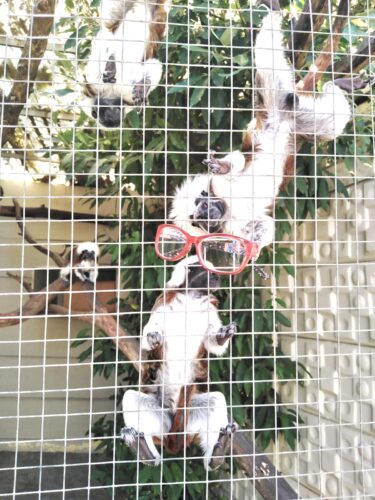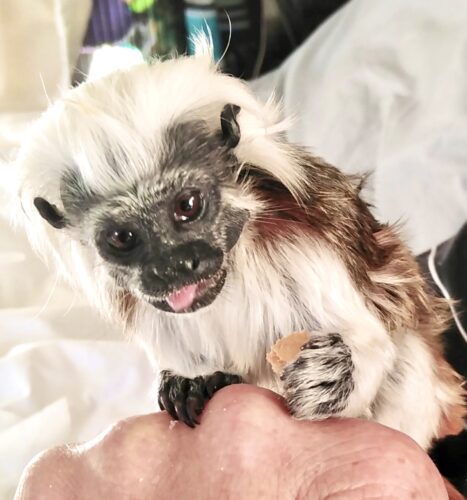
Saguinus oedipus
Our Cottontop Tamarins Saguinus Oedipus, are on the ‘critically endangered’ species list and what’s more is we are extremely proud to be the only primate breeders in Southern Africa to own these magnificent specimen!
Appearance & Physical attributes:
The Cottontop Tamarin can be easily recognised by their long, white sagittal crest extending from its forehead flowing over its shoulders, furthermore, the fur on their chest and arms are also white. The cottontop tamarins of which there are three various types, all have a chestnut brown fur covering all of the body except the palms of the hands and feet, the eyelids, and the borders of the nostrils. Moreover, the fur is distributed with varying densities and colourations throughout the body. The skin of the face is black with grey or white bands located above the eyes. These bands continue along the edge of the face down to the jaw. What’s more is, the cotton-top tamarin, like other callitrichids, has two molar teeth on each side of its jaw, not three like other New World Primates.
Natural Habitat:
The cottontop tamarin originates from a small area of northwest Colombia.
Conservation Status:
The wild population is estimated at 6,000 individuals, with 2,000 being adults. This species is critically endangered, and was listed in “The World’s 25 Most Endangered Primates between 2008 and 2012.
Lifespan:
This variety of Tamarin monkey are amongst some of the smallest primates and live between thirteen to approximately 24 years.
We have included official References below should you wish to learn more about the Cottontop Tamarin..
References:
- Groves, C. P. (2005). Wilson, D. E.; Reeder, D. M. (eds.). Mammal Species of the World: A Taxonomic and Geographic Reference (3rd ed.). Baltimore: Johns Hopkins University Press. p. 135. ISBN 0-801-88221-4. OCLC 62265494.
- ^ Jump up to: a b c d e f g h i j V., Link, A., Guzman-Caro, D., Defler, T.R., Palacios, E., Stevenson, P.R. & Mittermeier, R.A. 2021. Saguinus oedipus (amended version of 2020 assessment). The IUCN Red List of Threatened Species 2021: e.T19823A192551067. https://dx.doi.org/10.2305/IUCN.UK.2021-1.RLTS.T19823A192551067.en. Downloaded on 06 April 2021.
- ^ “Appendices | CITES”. cites.org. Retrieved 2022-01-14.
- ^ Burton, R. (2002). “Pinché tamarin”. In Burton, M. (ed.). Marshall Cavendish International Wildlife Encyclopedia. Vol. 19. Marshall Cavendish. p. 2625. ISBN 978-0-86307-949-8.
- ^ Jump up to: a b c d e f g h Cawthon Lang, K. A. (18 May 2005). “Primate Factsheets: Cotton-top tamarin (Saguinus oedipus) Taxonomy, Morphology, & Ecology”. Primate Info Net. Wisconsin Primate Research Center (WPRC) Library. Retrieved 19 November 2012.
- ^ German Wikipedia article
- ^ Linnaeus, Carolus (1758). Systema naturae per regna tria naturae, secundum classes, ordines, genera, species, cum characteribus, differentiis, synonymis, locis. Tomus I. Editio decima, reformata (in Latin). Holmiae (Laurentii Salvii). p. 28.
- ^ Beolens, B.; Watkins, M.; Grayson, M. (2009). The Eponym Dictionary of Mammals. Johns Hopkins University Press. p. 296. ISBN 978-0-8018-9533-3.
- ^ Jump up to: a b c d Estrada, A. (2006). New Perspectives in the Study of Mesoamerican Primates: Distribution, Ecology, Behavior, and Conservation. Springer. p. 35. ISBN 0-387-25854-X.
- ^ Jump up to: a b Hernández-Camacho, J.; Cooper, R. W. (1976). “The nonhuman primates of Colombia”. In Thorington Jr., J. R.; Heltne, P. G. (eds.). Neotropical Primates: Field Studies and Conservation. National Academy of Sciences. pp. 35–69.
- ^ Defler, T. (2004). Mahecha, J. V. R. (ed.). Primates of Colombia (2nd ed.). CONSERVATION International. ISBN 978-1-881173-83-0.
- ^ Jump up to: a b c d Hershkovitz, P. (1977). “Saguinus oedipus Linnaeus, Crested Tamarins: 1. History, Characters, Evolution, and Subspecies; and 2. Biology of Crested Bare-face Tamarins”. Living New World Monkeys (Platyrrhini): with an Introduction to Primates. University of Chicago Press. pp. 753–. ISBN 978-0-226-32788-4.
- ^ Eisenberg, J. F.; Redford, K. H. (1999). “The Contemporary Mammalian Fauna: Order Primates”. Mammals of the Neotropics: The Central Neotropics: Ecuador, Peru, Bolivia, Brazil. University of Chicago Press. pp. 230–. ISBN 978-0-226-19542-1.
- ^ Jump up to: a b Garber, P. A. (1993). “Feeding ecology and behaviour of the genus Saguinus“. In Rylands, A. B. (ed.). Marmosets and Tamarins: Systematics, Behaviour, and Ecology. Oxford University Press. ISBN 978-0-19-854022-9.
- ^ Fleagle, J. G. (1998). Primate Adaptation and Evolution(2nd ed.). Academic Press. p. 165. ISBN 978-0-12-260341-9.
- ^ Jump up to: a b c d Neyman, P. F. (1978). “Aspects of the ecology and social organization of free-ranging cotton-top tamarins (Saguinus oedipus) and the conservation status of the species”. In Kleiman, D. G. (ed.). The Biology and Conservation of the Callitrichidae (PDF). Smithsonian Institution Press. pp. 39–71. ISBN 978-0-87474-587-0.
- ^ Snowdon, C. T.; Soini, P. (1988). “The tamarins, genus Saguinus“. In Mittermeier, R. A.; Coimbra-Filho, A. F.; da Fonseca, G. A. B. (eds.). Ecology and Behavior of Neotropical Primates. Vol. 2. World Wildlife Fund. pp. 223–298.
- ^ Sussman, R. W. (2000). Primate Ecology and Social Structure. Volume 2, New World Monkeys. Pearson Preston Hall. pp. 207–. ISBN 978-0-536-74364-0.
- ^ Jump up to: a b Savage, A.; Giraldo, L. H.; Soto, L. H.; Snowdon, C. T. (1996). “Demography, group composition, and dispersal in wild cotton-top tamarin (Saguinus oedipus) groups”. American Journal of Primatology. 38: 85–100. doi:10.1002/(SICI)1098-2345(1996)38:1<85::AID-AJP7>3.0.CO;2-P. PMID 31914712. S2CID 84120098.
- ^ Jump up to: a b c d e f Sproul, C.; Palleroni, A.; Hauser, M. D. (2006). “Cottontop tamarin, Saguinus oedipus, alarm calls contain sufficient information for recognition of individual identity”. Animal Behaviour. 72 (6): 1379. doi:10.1016/j.anbehav.2006.04.006. S2CID 53182811.
- ^ Jump up to: a b c Cronin, K. A.; Schroeder, K. K. E.; Snowdon, C. T. (2010). “Prosocial behaviour emerges independent of reciprocity in cottontop tamarins”. Proceedings of the Royal Society B: Biological Sciences. 277 (1701): 3845–3851. doi:10.1098/rspb.2010.0879. hdl:11858/00-001M-0000-0012-2865-B. PMC 2992700. PMID 20630886.
- ^ Savage, A.; Snowdon, C. T.; Giraldo, L. H.; Soto, L. H. (1996). “Parental care patterns and vigilance in wild cotton-top tamarins (Saguinus oedipus)”. In Norconk, M. A.; Rosenberger, A. L.; Garber, P. A. (eds.). Adaptive Radiations of Neotropical Primates. Plenum Press. pp. 187–199. ISBN 978-0-306-45399-1.
- ^ Savage, A.; Ziegler, T. E.; Snowdon, C. T. (1988). “Sociosexual development, pair bond formation, and mechanisms of fertility suppression in female cotton-top tamarins (Saguinus oedipus oedipus)”. American Journal of Primatology. 14 (4): 345. doi:10.1002/ajp.1350140404. S2CID 85779307.
- ^ Heistermann, M.; Kleis, E.; Pröve, E.; Wolters, H. J. R. (1989). “Fertility status, dominance, and scent marking behavior of family-housed female cotton-top tamarins (Saguinus oedipus) in absence of their mothers”. American Journal of Primatology. 18 (3): 177–189. doi:10.1002/ajp.1350180302. PMID 31964031. S2CID 85794285.
- ^ Savage, A.; Shideler, S. E.; Soto, L. H.; Causado, J.; Giraldo, L. H.; Lasley, B. L.; Snowdon, C. T. (1997). “Reproductive events of wild cotton-top tamarins (Saguinus oedipus) in Colombia”. American Journal of Primatology. 43(4): 329–337. doi:10.1002/(SICI)1098-2345(1997)43:4<329::AID-AJP4>3.0.CO;2-Z. PMID 9403097. S2CID 6750233.
- ^ Jump up to: a b Cleveland, J.; Snowdon, C. T. (1984). “Social development during the first twenty weeks in the cotton-top tamarin (Saguinus o. oedipus)”. Animal Behaviour. 32 (2): 432. doi:10.1016/S0003-3472(84)80279-1. S2CID 53189140.
- ^ Jump up to: a b Tardif, S. D.; Bales, K. (1997). “Is infant-carrying a courtship strategy in callitrichid primates?”. Animal Behaviour. 53 (5): 1001. doi:10.1006/anbe.1996.0353. S2CID 3714267.
- ^ Jump up to: a b c Sánchez, S.; Peláez, F.; Gil‐Bürmann, C.; Kaumanns, W. (1999). “Costs of infant‐carrying in the cotton‐top tamarin (Saguinus oedipus)”. American Journal of Primatology. 48(2): 99–111. doi:10.1002/(SICI)1098-2345(1999)48:2<99::AID-AJP2>3.0.CO;2-6. PMID 10333430. S2CID 31747571.
- ^ Achenbach, G. G.; Snowdon, C. T. (2002). “Costs of caregiving: weight loss in captive adult male cotton-top tamarins (Saguinus oedipus) following the birth of infants”. International Journal of Primatology. 23 (1): 179–189. doi:10.1023/A:1013210226793. PMC 1483063. PMID 16804560.
- ^ Washabaugh, K. F.; Snowdon, C. T.; Ziegler, T. E. (2002). “Variations in care for cottontop tamarin, Saguinus oedipus, infants as a function of parental experience and group size”. Animal Behaviour. 63 (6): 1163. doi:10.1006/anbe.2002.3018. S2CID 53167116.
- ^ Hauser, M. D.; Chen, M. K.; Chen, F.; Chuang, E. (2003). “Give unto others: Genetically unrelated cotton-top tamarin monkeys preferentially give food to those who altruistically give food back”. Proceedings of the Royal Society B: Biological Sciences. 270 (1531): 2363–2370. doi:10.1098/rspb.2003.2509. PMC 1691522. PMID 14667352.
- ^ Jump up to: a b c d Hauser, M.; McAuliffe, K.; Blake, P. R. (2009). “Evolving the ingredients for reciprocity and spite”. Philosophical Transactions of the Royal Society B: Biological Sciences. 364 (1533): 3255–3266. doi:10.1098/rstb.2009.0116. PMC 2781875. PMID 19805432.
- ^ Clutton-Brock, T. H.; Parker, G. A. (1995). “Punishment in animal societies”. Nature. 373 (6511): 209–216. doi:10.1038/373209a0. PMID 7816134. S2CID 21638607.
- ^ Hammerstein, P. (2003). “Why is reciprocity so rare in social animals? A protestant appeal”. The Genetic and Cultural Evolution of Cooperation. MIT Press. pp. 83–93. ISBN 978-0-262-08326-3.
- ^ Byrne, R. W. (1994). “The evolution of intelligence”. In Slater, P. J. B.; Halliday, T. R. (eds.). Behavior and Evolution. Cambridge University Press. pp. 223–265. ISBN 978-0-521-42923-8.
- ^ Kleiman, D. G. (1979). “Parent-offspring conflict and sibling competition in a monogamous primate” (PDF). American Naturalist. 114 (5): 753–760. doi:10.1086/283524. S2CID 55162428.
- ^ Jump up to: a b c French, J. A.; Snowdon, C. T. (1981). “Sexual dimorphism in responses to unfamiliar intruders in the tamarin, Saguinus oedipus“. Animal Behaviour. 29 (3): 822. doi:10.1016/S0003-3472(81)80016-4. S2CID 53151699.
- ^ Jump up to: a b c d e Cleveland, J.; Snowdon, C. T. (1982). “The complex vocal repertoire of the adult cotton-top tamarin (Saguinus oedipus oedipus)”. Zeitschrift für Tierpsychologie. 58 (3): 231. doi:10.1111/j.1439-0310.1982.tb00320.x.
- ^ Jump up to: a b c d e Castro, N.; Snowdon, C. (2000). “Development of vocal responses in infant cotton-top tamarins”. Behaviour. 137 (5): 629. doi:10.1163/156853900502259.
- ^ “Cotton-top Tamarin”. Oakland Zoo. Archived from the original on 18 June 2012. Retrieved 20 June 2012.
- ^ Jump up to: a b Weiss, D.; Garibaldi, B.; Hauser, M. D. (2001). “The production and perception of long calls by cotton-top tamarins (Saguinus oedipus): acoustic analyses and playback experiments”. Journal of Comparative Psychology. 115 (3): 258–271. doi:10.1037/0735-7036.115.3.258. PMID 11594495.
- ^ Weiss, D.; Hauser, M. (2002). “Perception of harmonics in the combination long call of cotton-top tamarins, Saguinus oedipus“. Animal Behaviour. 64 (3): 415–426. doi:10.1006/anbe.2002.3083. S2CID 49480605.
- ^ Miller, C. T.; Ghazanfar, A. A. (2002). “Meaningful acoustic units in nonhuman primate vocal behavior”. In Bekoff, M.; Allen, C.; Burghardt, G. (eds.). Cognitive Animal: Empirical and Theoretical Perspectives on Animal Cognition. MIT Press. pp. 265–274. ISBN 978-0-262-52322-6.
- ^ Jump up to: a b Elowson, A. M.; Tannenbaum, P. L.; Snowdon, C. T. (1991). “Food-associated calls correlate with food preferences in cotton-top tamarins”. Animal Behaviour. 42(6): 931. doi:10.1016/S0003-3472(05)80145-9. S2CID 53252085.
- ^ Jump up to: a b Roush, R. S.; Snowdon, C. T. (2001). “Food transfer and development of feeding behavior and food-associated vocalizations in cotton-top tamarins”. Ethology. 107 (5): 415–429. doi:10.1046/j.1439-0310.2001.00670.x.
- ^ Mittermeier, R. A.; Wallis, J.; Rylands, A. B.; Ganzhorn, J. U.; Oates, J. F.; Williamson, E. A.; Palacios, E.; Heymann, E. W.; Kierulff, M. C. M.; Long Yongcheng; Supriatna, J.; Roos, C.; Walker, S.; Cortés-Ortiz, L.; Schwitzer, C., eds. (2009). Primates in Peril: The World’s 25 Most Endangered Primates 2008–2010 (PDF). Illustrated by S. D. Nash. IUCN/SSC Primate Specialist Group (PSG), International Primatological Society (IPS), and Conservation International (CI). pp. 1–92. ISBN 978-1-934151-34-1.
- ^ Mittermeier, R. A.; Schwitzer, C.; Rylands, A. B.; Taylor, L. A.; Chiozza, F.; Williamson, E. A.; Wallis, J., eds. (2012). “Primates in Peril: The World’s 25 Most Endangered Primates 2012–2014” (PDF). Illustrated by S. D. Nash. IUCN/SSC Primate Specialist Group (PSG), International Primatological Society (IPS), and Conservation International (CI): 1–40. Archived from the original (PDF) on 2013-10-21. Retrieved 2013-03-04.
- ^ Jump up to: a b Cawthon Lang, K. A. (18 May 2005). “Primate Factsheets: Cotton-top tamarin (Saguinus oedipus) Conservation”. Primate Info Net. Wisconsin Primate Research Center (WPRC) Library. Retrieved 5 March 2013.
- ^ “Proyecto Tití”. Proyecto Tití. Retrieved 29 May 2013.
- ^ “Cotton-top Tamarin Conservation”. Wildlife Conservation Network. Retrieved 29 May 2013.
- ^ Associated Press (2015-01-13). “2 endangered monkeys die from cold temperatures at Louisiana zoo”. Associated Press. Archived from the original on 17 January 2015. Retrieved 16 January 2015.
- ^ Phillip, Abby (2015-01-14). “Two critically endangered monkeys freeze to death after a Louisiana zoo keeper left them outside”. Washington Post. Retrieved 16 January2015.




